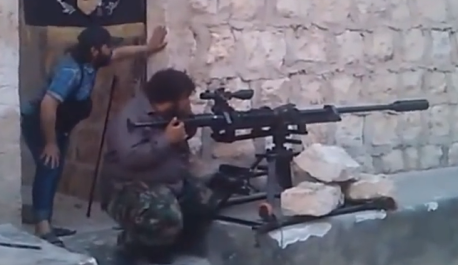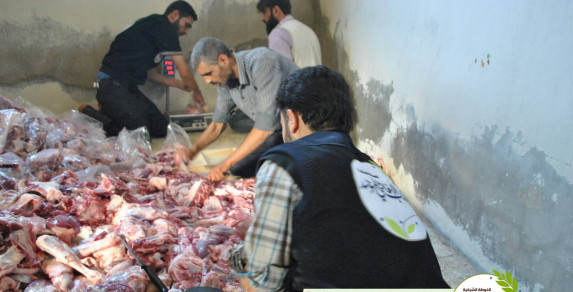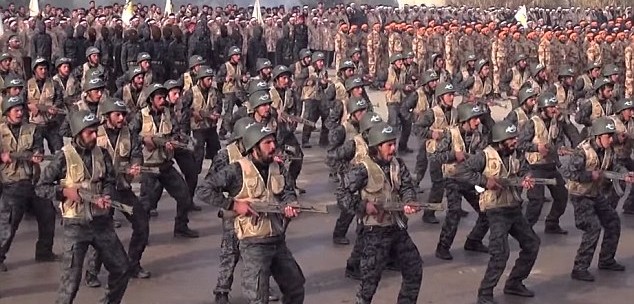PHOTO: Graduating Jaish al-Islam troops, December 2015
The OSINT Blog, a specialist site on open-source Intelligence and analysis focusing on the Middle East and South/Central Asia, considers the economics and weapons behind the survival of the rebel faction Jaish al-Islam.
Based near Damascus, Jaish al-Islam has withstood years of regime bombardment and sieges to become one of the leading rebel movements in the five-year conflicts.
….Jaish al-Islam operates in a fairly tough environment in their stronghold of East Ghouta, as they are cut off from core rebel territories in the Idlib/Aleppo and Daraa Governorates. They are also under a crippling Syrian government siege that restricts the flow of supplies and food into their territories. Despite this situation, Jaish al-Islam manages to remain one of the most professional rebel groups in Syria. Jaish al-Islam’s management of the economy in East Ghouta is a major factor in their continued survival while under siege.
Ammunition, food, water, weaponry, support population and funding are all required to successfully conduct military operations. Without these key factors, Jaish al-Islam would be unable to operate as successfully as they do.
Smuggling and Tunneling
Smuggling is a key factor in allowing Jaish al-Islam to survive under siege in East Ghouta. Bribery and graft within pro-government forces allows Jaish al-Islam to move goods into the East Ghouta pocket. Corrupt Syrian Arab Army officers are known to sell supplies and weaponry to Jaish al-Islam at inflated rates. For instance, Jaish al-Islam bought two T-72 tanks from an SAA officer back in 2014.
According to Siege Watch, in the Damascus area only Douma and Jobar are under complete siege with little to no transfer of goods and supplies from across government lines. However, the vast majority of the other sieges in E. Ghouta are not ranked as “Tier 1” sieges according to Siege Watch; this indicates that some passage of supplies from government areas into rebel areas occurs.
Jaish al-Islam also operates several underground smuggling tunnels in the area. The suburb of Jobar, for instance, is linked to East Ghouta through a network of tunnels. These tunnels reduce the effectiveness of the near total government siege on Jobar. Other tunnel networks allow the transfer of supplies into East Ghouta and ensure Jaish al-Islam’s leadership can leave and enter the E. Ghouta pocket at will. For example, Jaish al-Islam’s former leader (now deceased) Zahran Alloush was able to travel from East Ghouta to Istanbul, Turkey despite the Syrian government blockade. The network of tunnels crisscrossing under East Ghouta makes it extremely hard for the Syrian government to totally blockade areas they are besieging.
Jaish al-Islam also uses tunneling as an offensive weapon to launch surprise attacks from behind enemy lines. The lead-up to the 2015 Tal Kurdi Offensive by Jaish al-Islam saw the construction of several infiltration tunnels. These tunnels are often large, well-lit and equipped with air flow systems. Some tunnels were large enough to comfortably allow the transport of dozens of fighters.
Unconventional Artillery and Munitions Manufacturing
Jaish al-Islam makes a variety of munitions for use in combat. While most rebel groups in Syria are limited to manufacturing improvised items such as IEDs or homemade grenades, Jaish al-Islam takes this a step further to manufacturing standardized munitions.
Jaish al-Islam does manufacture a variety of non-standard munitions including the infamous “hell cannon”, essentially an improvised mortar of firing an improvised projectile usually consisting of a propane tank packed with explosives.
Jaish al-Islam also makes and uses improvised rocket artillery called IRAMs (Improvised Rocket Assisted Munitions). This style of improvised rocket artillery was popularized by various Shia militias that used them against American forces during the insurgency phase of the Iraq War.
IRAMs are essentially an oversized improvised warhead (usually a propane tank or drum filled with explosives and shrapnel) attached to a small rocket motor. When compared to most standard rocket artillery, IRAMs are relatively short range (mostly due to their large oversized warhead). They are also notoriously inaccurate due to their unconventional shape….While Jaish al-Islam IRAMs tend to be less impressive and generally weaker than the infamous “volcano rockets” used by the Syrian Army, IRAMs are still an important armament in Jaish al-Islam’s arsenal.
IEDs (improvised explosive device) are also a common non-standard munition utilized by Jaish al-Islam. Jaish al-Islam seems to employ IEDs in ambushes, and they also use IEDs to shut down Syrian government movement of roads. For instance, Jaish al-Islam has repeatedly employed IEDs to try to shut down Syrian government usage of the M5 highway between Damascus and Homs. Jaish al-Islam does not seem to manufacture IEDs on a large scale. Furthermore, Jaish al-Islam does not appear to use IEDs at frequently as ISIS [the Islamic State] or other rebel groups.
Improvised grenades are also manufactured by Jaish al-Islam. These improvised grenades are rather small and almost exclusively rely on an external fuse that must be manually lit with a lighter or match prior to usage. This style of improvised grenade is incredibly common across Syria among a variety of non-state actors ranging from small FSA groups to ISIS. The effectiveness of these improvised grenades is unclear due to the lack of standardization among grenade designs.
Jaish al-Islam attack on Damascus Central Prison, September 2015
Conventional Artillery Manufacturing
While Jaish al-Islam’s IRAMs and hell cannons may be quite effective, Jaish al-Islam’s manufacturing of conventional artillery systems is what makes it stand out among the various rebel groups in Syria. Jaish al-Islam makes or modifies a variety of conventional artillery pieces that fire standard munitions. We will examine just a few of the conventional artillery pieces that have been modified or built by Jaish al-Islam.
Modification of existing artillery pieces by rebel groups in Syria is quite common. Jaish al-Islam modifies a variety of artillery systems. For instance, they have upgraded Type-63 MLRS (Multiple Launch Rocket System) with a more durable off-road chassis as well as adding a new camouflage paint-job.
Jaish al-Islam has been spotted using a locally manufactured analog of the 9K132 Grad-P. This variant of the Grad is essentially a single tube that fires a single Grad rocket. This system allows for the firing of individual grad rockets in areas where a truck mounted grad system may not be useable. Jaish al-Islam’s Grad-P analog is extremely similar to the original system in both construction and design; furthermore, like the actual Grad-P, their Grad-P analog is man-portable.
Probably one of the pinnacles of Jaish al-Islam’s artillery manufacturing was the creation of the Sahm al-Islam 3 (Arabic: سهم الإسلام) MLRS. “Sahm al-Islam” translates to “Arrow of Islam,” which is a somewhat apt name given the three 122mm rockets that system is armed with. These rockets are launched from an elevating and rotating firing platform that is mounted onto a 6×6 Ural-375D. The Ural-375D is the vehicle used in the BM-21 Grad MLRS; thus, its use as an MLRS platform in Jaish al-Islam’s Sahm al-Islam 3 system is not strange. The Sahm al-Islam 3 MLRS can also carry up to two 122mm rockets in reserve.
Conventional Munitions Manufacturing
Jaish al-Islam makes a variety of conventional munitions as well. Jaish al-Islam used to control significant portions of Adra industrial city giving them access to significant amounts of machinery that could have been used for the production of munitions. Furthermore, there are a significant number of factories and foundries within Douma and other urban areas within East Ghouta.
Jaish al-Islam manufactures both mortar rounds and rockets. While they make a large variety of large and small caliber mortar rounds, they seem to only make 107mm and 122mm rockets. The 107mm rocket is seemingly designed to be fired from a Type-63 style MLRS. It is uncertain how effective or accurate these rockets are, though there are multiple videos from 2013 of their 122mm “Sahm al-Islam 3” rocket being successfully fired. It is unclear if these rockets are being produced on any significant scale by Jaish al-Islam. To the best of our knowledge, 122mm “Sahm al-Islam 3” rockets have not been seen since late 2013….
General Supplies Manufacturing
Jaish al-Islam appears to make their own uniforms. While this is not particularly unusual among non-state actors (the LTTE for instance made their own camouflage uniforms), it is not common for camouflage uniforms to be manufactured on a large scale among rebel groups in Syria. While all Jaish al-Islam fighters do not wear standardized uniforms, high level leadership and special forces tend to wear them. Jaish al-Islam not only makes camouflage pants and shirts, they also make standardized boots for their soldiers.
Jaish al-Islam also appears to make their own saline solution for usage as intravenous fluid in hospitals and on the battlefield. While the group does have a fairly well developed medical corp, we were unable to find any video footage showing the actual production process for saline. The video showcasing the saline solution did show the usage of a sterilizing machine, but it is unclear if that was relevant to the production of saline solution.
Anti-MateriEl and Sniper Rifle Manufacturing
Jaish al-Islam manufactures a large variety of sniper and anti-materiel rifles. In addition to allowing the engagement of targets far outside the range of most small arms, these rifles can also easily destroy weaponry, supplies, and unarmored vehicles. The use of large caliber machine guns in a sniper role is not uncommon; the Vietnam war saw the use of the .50 Caliber Browning M2 machine gun as a sniper and the 12.7mm Soviet NSV machine gun was re-purposed as a sniper during the Soviet War in Afghanistan.
Jaish al-Islam seems to repurpose barrels from machine guns and anti-aircraft guns to make their anti-materiel rifles. These weapons seem to be effective and several videos have been released of them accurately targeting Syrian government forces. In some cases they appear to have manufactured the rifle barrel themselves, while in others they have simply reused a barrel from another weapon.

Jaish al-Islam fighters with an anti-materiel rifle
Agriculture and Animal Husbandry
In Syria we have seen that siege tactics are a somewhat effective strategy to weaken the operational capability of a non-state actor. Both the Syrian government and the rebels have employed siege tactics through denying the passage of food, gasoline and other supplies to enemy-controlled territory.
Rebel held pockets under government blockade often face starvation and food insecurity. A particularly relevant example is the Damascus suburb of Moadamiya, which is under a crippling government siege. The “Mouadamiya Council,” which is in charge of running the city, has alleged that the government’s restriction of food supply to the suburb leads to much of the civilian population fleeing to government controlled areas. This also has the effect of weakening rebels who depend on the support of the civilian population to operate effectively
East Ghouta, however, has not experienced food insecurity or starvation of the scale seen in Moadamiya. This is largely attributable to the rural nature of East Ghouta and its large number of farms, poultry farms, and slaughter houses….

Aid workers in East Ghouta prepare meat for distribution
Conclusion
Jaish al-Islam is not your ordinary Syrian rebel group; while it may not have the large scale presence of Ahrar al-Sham or Jabhat al-Nusra, it is clearly one of the most well organized rebel groups in Syria. As far as conventional weapons and munitions manufacturing among non-state actors is concerned, Jaish al-Islam is by far the most successful at it. While it is quite clear that their heavy backing by Saudi Arabia and Turkey plays a significant role in their manufacturing capabilities, a large portion of the manufacturing equipment they use, such as forges, lathes and sterilization machines, are simply too large to have been smuggled in with the support of their foreign backers.
Jaish al-Islam’s management of the economy in East Ghouta plays a major role in the groups continued dominance among rebels in the Damascus area. Their ability to conduct massive coordinated offensives such as the 2015 Tal Kurdi Offensive is in part thanks to their ability to manufacture their own munitions. Jaish al-Islam is and will remain a major player within the Syrian Civil War for some time to come.

